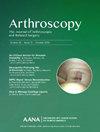半月板同种异体移植同时进行软骨修复或截骨术的 2 年再手术率无差异:一项国家数据库研究。
IF 4.4
1区 医学
Q1 ORTHOPEDICS
Arthroscopy-The Journal of Arthroscopic and Related Surgery
Pub Date : 2025-05-01
DOI:10.1016/j.arthro.2024.06.022
引用次数: 0
摘要
目的:调查半月板同种异体移植(MAT)后的再手术率,并利用全国保险理赔数据库比较有无同时进行关节软骨和截骨手术的再手术率:我们利用PearlDiver数据库对2010年至2021年期间接受半月板异位移植手术且至少随访2年的患者进行了一项回顾性队列研究。我们使用现行手术术语(CPT)和国际疾病分类(ICD)代码,确定了同时接受软骨成形术或微骨折术、软骨修复术(定义为骨软骨移植术或自体软骨细胞植入术(ACI))或截骨术等手术的患者。单变量逻辑回归确定了再次手术的风险因素。再手术分为膝关节置换术、介入手术、诊断或清创手术:共纳入 750 名患者,平均年龄为 29.6 岁(四分位数间距为 21.0-36.8),平均随访时间为 5.41 年(标清:2.51)。90天、2年和历次再手术率分别为1.33%、14.4%和27.6%。软骨修复的 MAT 与 90 天的再手术率增加有关(OR:4.88;95% CI:1.38-19.27;P=.015),但 2 年或随访结束时的再手术率没有显著差异。ACI会增加90天的再手术率(OR:6.95;95% CI:1.45-25.96;p=.006),术后2年或随访结束时的再手术率没有差异。骨软骨自体移植和异体移植与再手术率的增加无关。近四分之一接受MAT的患者同时进行了软骨修复,这表明MAT在关节软骨损伤患者中很常见。同时进行的骨软骨自体移植、骨软骨异体移植、软骨成形术、微骨折和截骨术与再手术率的显著差异无关。ACI与90天后再手术率的增加有关,但与90天后再手术率的增加无关。本文章由计算机程序翻译,如有差异,请以英文原文为准。
No Differences in 2-Year Reoperation Rates for Meniscus Allograft Transplant With Concomitant Cartilage Restoration or Osteotomy: A National Database Study
Purpose
To investigate reoperation rates after meniscus allograft transplant (MAT), comparing rates with and without concomitant articular cartilage and osteotomy procedures using a national insurance claims database.
Methods
We performed a retrospective cohort study of patients who underwent MAT from 2010 to 2021 with a minimum 2-year follow-up using the PearlDiver database. Using Current Procedural Terminology and International Classification of Diseases codes, we identified patients who underwent concomitant procedures including chondroplasty or microfracture, cartilage restoration defined as osteochondral graft or autologous chondrocyte implantation (ACI), or osteotomy. Univariate logistic regressions identified risk factors for reoperation. Reoperations were classified as knee arthroplasty, interventional procedures, or diagnostic or debridement procedures.
Results
The study included 750 patients with an average age of 29.6 years (interquartile range: 21.0-36.8) and average follow-up time was 5.41 years (SD: 2.51). Ninety-day, 2-year, and all-time reoperation rates were 1.33%, 14.4%, and 27.6%, respectively. MAT with cartilage restoration was associated with increased reoperation rate at 90 days (odds ratio: 4.88; 95% confidence interval: 1.38-19.27; P = .015); however, there was no significant difference in reoperation rates at 2 years or to the end of follow-up. ACI had increased reoperation rates at 90 days (odds ratio: 6.95; 95% confidence interval: 1.45-25.96; P = .006), with no difference in reoperation rates 2 years postoperatively or to the end of follow-up. Osteochondral autograft and allograft were not associated with increased reoperation rates.
Conclusions
In our cohort, 14.4% of patients had a reoperation within 2 years of MAT. Nearly 1 in 4 patients undergoing MAT had concomitant cartilage restoration, showing that it is commonly performed on patients with articular cartilage damage. Concomitant osteochondral autograft, osteochondral allograft, chondroplasty, microfracture, and osteotomy were not associated with any significant difference in reoperation rates. ACI was associated with increased reoperation rates at 90 days, but not later.
Level of Evidence
Level IV, retrospective cohort study.
求助全文
通过发布文献求助,成功后即可免费获取论文全文。
去求助
来源期刊
CiteScore
9.30
自引率
17.00%
发文量
555
审稿时长
58 days
期刊介绍:
Nowhere is minimally invasive surgery explained better than in Arthroscopy, the leading peer-reviewed journal in the field. Every issue enables you to put into perspective the usefulness of the various emerging arthroscopic techniques. The advantages and disadvantages of these methods -- along with their applications in various situations -- are discussed in relation to their efficiency, efficacy and cost benefit. As a special incentive, paid subscribers also receive access to the journal expanded website.

 求助内容:
求助内容: 应助结果提醒方式:
应助结果提醒方式:


